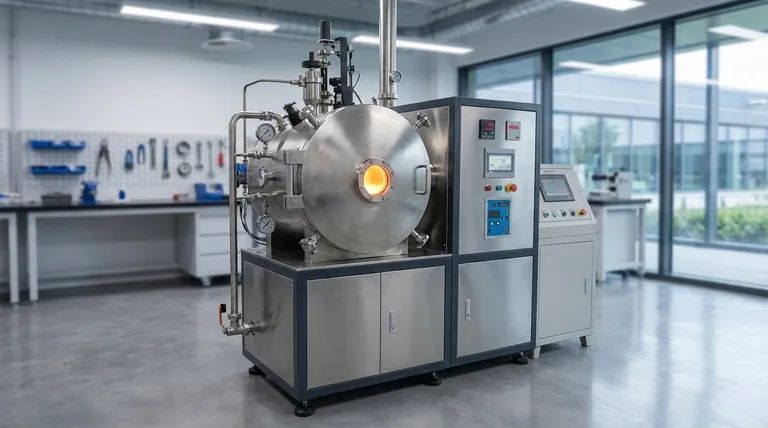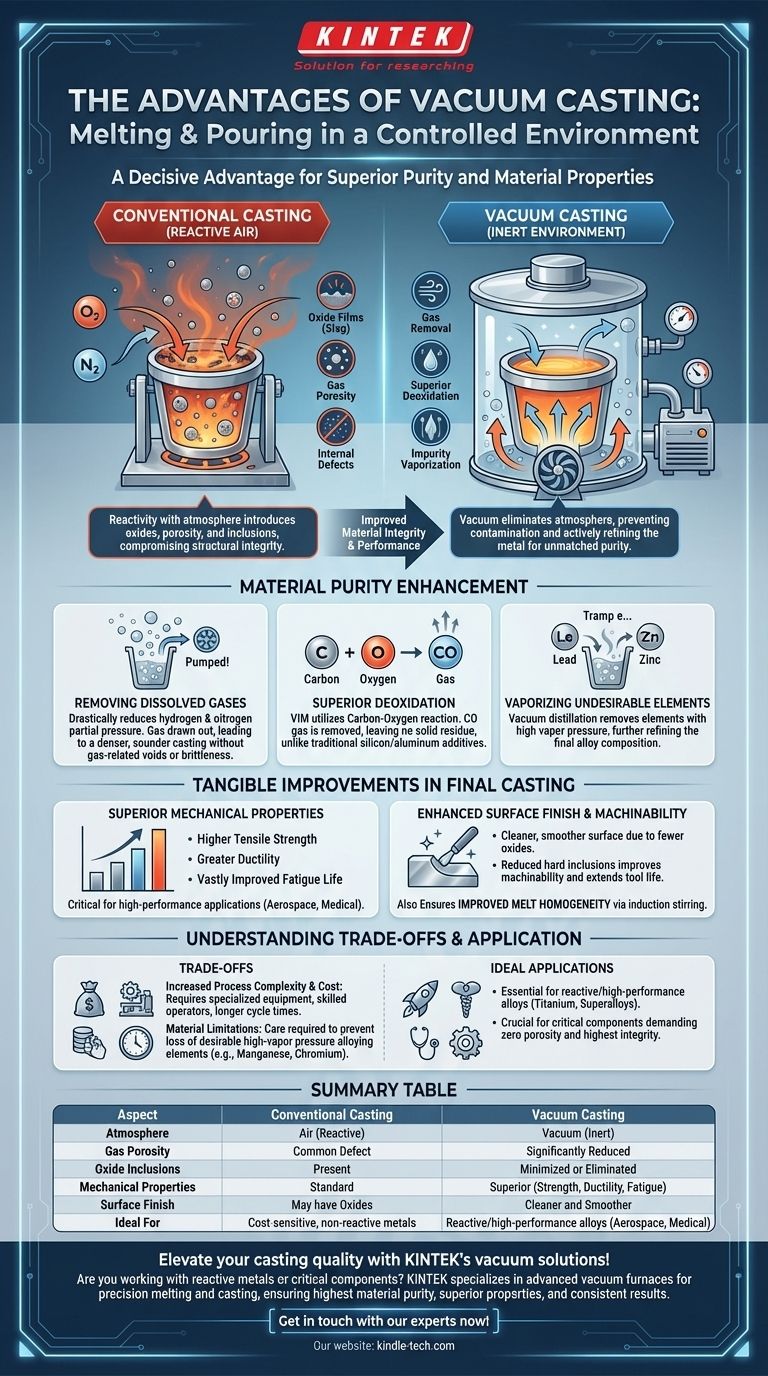Performing melting and pouring of casting in a vacuum provides a decisive advantage by fundamentally altering the processing environment. This controlled atmosphere eliminates gas-related defects and removes impurities, leading to a final product with significantly higher purity, superior mechanical properties, and an improved surface finish. The process is not merely a shield against air but an active refining tool.
The core problem with conventional casting is the reactivity of molten metal with the atmosphere, which introduces defects like oxides and gas porosity. Vacuum casting solves this by removing the atmosphere entirely, enabling a level of purity and material integrity that is otherwise unattainable.
The Core Principle: Eliminating Unwanted Reactions
Molten metals are highly susceptible to contamination from the surrounding air. A vacuum environment is the most effective way to prevent these detrimental interactions.
Why Molten Metal is Reactive
At high temperatures, liquid metals readily react with oxygen and nitrogen in the air. This causes the formation of oxide films (slag) and the absorption of gases into the melt.
These absorbed gases and oxides become trapped during solidification, creating internal defects that compromise the casting's structural integrity.
How a Vacuum Changes the Environment
A vacuum is more than just an inert shield like argon gas; it is an active processing environment. The low-pressure condition not only prevents contamination but actively pulls unwanted elements out of the molten metal.
This "vacuum degassing" effect is central to the benefits of the process, as it allows for a level of cleaning and refining that cannot be achieved in any other environment.
Key Advantages in Material Purity
The primary benefit of vacuum casting is the ability to produce exceptionally clean and pure metal, free from the common defects introduced by atmospheric exposure.
Removing Dissolved Gases
Gases like hydrogen and nitrogen, absorbed from the atmosphere or raw materials, are a primary cause of porosity. A vacuum drastically reduces the partial pressure of these gases above the melt, causing them to be drawn out and pumped away.
This results in a denser, sounder casting with a significant reduction in gas-related voids and brittleness.
Achieving Superior Deoxidation
In conventional melting, deoxidation is achieved by adding elements like silicon or aluminum, which react with oxygen to form solid oxides. These oxides can remain in the metal as non-metallic inclusions, creating weak points.
In vacuum induction melting (VIM), deoxidation can be accomplished via the carbon-oxygen reaction. Carbon in the melt reacts with oxygen to form carbon monoxide (CO) gas, which is then simply pumped out of the system, leaving no solid residue behind.
Vaporizing Undesirable Elements
The low-pressure environment of a vacuum furnace can also be used to remove unwanted "tramp elements" with high vapor pressures, such as lead, zinc, or cadmium.
This process, known as vacuum distillation, effectively boils these impurities out of the melt, further enhancing the purity of the final alloy.
Understanding the Trade-offs
While the benefits are significant, vacuum casting is a specialized process with important considerations. It is not the right solution for every application.
Increased Process Complexity and Cost
Vacuum furnaces and pumping systems represent a substantial capital investment. The process requires highly skilled operators and longer cycle times compared to conventional air melting, increasing operational costs.
Material Limitations
The same principle that removes undesirable volatile elements can also remove desirable alloying elements if they have a high vapor pressure. The composition of the alloy must be carefully managed to prevent the loss of critical components like manganese or chromium.
Melting vs. Pouring Protection
It's important to distinguish between vacuum melting and vacuum pouring. Some processes melt under vacuum but pour in an inert atmosphere (like argon) to protect the metal stream.
A full vacuum melting and pouring cycle offers the highest level of protection but also represents the greatest complexity.
Tangible Improvements in the Final Casting
The improvements in purity directly translate into measurable enhancements in the performance and quality of the finished component.
Superior Mechanical Properties
The reduction of inclusions and porosity leads to castings with significantly improved mechanical properties. This includes higher tensile strength, greater ductility, and vastly improved fatigue life, which are critical for high-performance applications.
Enhanced Surface Finish and Machinability
With fewer surface oxides forming during the process, vacuum-cast parts exhibit a much cleaner and smoother surface finish. The absence of hard, abrasive inclusions also improves the material's machinability, reducing tool wear and costs.
Improved Melt Homogeneity
In Vacuum Induction Melting (VIM), the induction currents vigorously stir the molten bath. This action, combined with the clean environment, ensures a highly uniform distribution of alloying elements and a more consistent, homogenous final product.
Making the Right Choice for Your Application
Choosing to use a vacuum process depends entirely on the material requirements and economic goals of your project.
- If your primary focus is producing reactive or high-performance alloys (e.g., superalloys, titanium): Vacuum melting is essential to achieve the required purity and mechanical properties demanded by aerospace or medical applications.
- If your primary focus is eliminating porosity and internal defects in critical components: Vacuum casting offers the most reliable method for degassing, ensuring the highest possible material integrity.
- If your primary focus is cost-sensitive, high-volume production of non-reactive metals: The high cost and complexity of vacuum processing may not be justifiable, and conventional methods with proper slag and gas management are more economical.
Ultimately, controlling the furnace atmosphere is a critical decision that directly determines the quality ceiling of your final casting.

Summary Table:
| Aspect | Conventional Casting | Vacuum Casting |
|---|---|---|
| Atmosphere | Air (reactive) | Vacuum (inert) |
| Gas Porosity | Common defect | Significantly reduced |
| Oxide Inclusions | Present | Minimized or eliminated |
| Mechanical Properties | Standard | Superior (strength, ductility, fatigue life) |
| Surface Finish | May have oxides | Cleaner and smoother |
| Ideal For | Cost-sensitive, non-reactive metals | Reactive/high-performance alloys (e.g., aerospace, medical) |
Elevate your casting quality with KINTEK's vacuum solutions!
Are you working with reactive metals like titanium or superalloys, or producing critical components where porosity and inclusions are unacceptable? KINTEK specializes in advanced lab and production equipment, including vacuum furnaces designed for precision melting and casting. Our technology ensures the highest material purity, superior mechanical properties, and consistent results for demanding applications in aerospace, medical, and research.
Contact us today to discuss how our vacuum casting expertise can help you achieve unparalleled quality and performance in your projects.
Get in touch with our experts now!
Visual Guide

Related Products
- Lab-Scale Vacuum Induction Melting Furnace
- Vacuum Heat Treat Furnace and Levitation Induction Melting Furnace
- Ultra-High Temperature Graphite Vacuum Graphitization Furnace
- Vacuum Heat Treat Sintering Brazing Furnace
- Vacuum Heat Treat Furnace with Ceramic Fiber Liner
People Also Ask
- What is vacuum arc melting technique? Discover the Precision of Vacuum Induction Melting
- How does a vim furnace work? Achieve Ultimate Purity in High-Performance Metal Melting
- What is VIM in metallurgy? A Guide to Vacuum Induction Melting for High-Performance Alloys
- What is vacuum induction melting used for? Creating Ultra-Pure Metals for Demanding Industries
- What is the vacuum induction method? Master High-Purity Metal Melting for Advanced Alloys



















